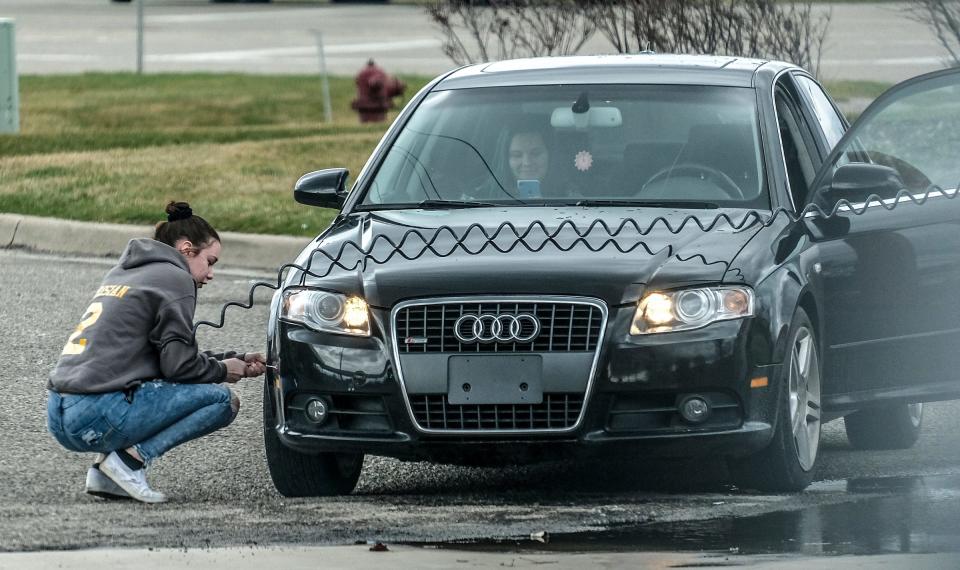Tips for your car in the cold weather: Inflate your tires, check fluids and full your tank
Artic air is on its way to Knoxville, bringing bitter cold temperatures and potentially the types of winter car troubles that Southerners typically get to avoid.
A changing weather pattern will cause a significant drop in temperatures across East Tennessee and maybe some snow this week, the National Weather Service said. Knoxville could have lows in the teens, highs in the upper 30s and even a 50% chance of snow.
Unfortunately, these cold temperatures can affect the mechanics of your car, from low tire pressure to dead batteries.
Here are a few pointers to help keep your car functioning as the temperatures dip.
Should you warm up your car?
It's not necessary. Gone are the days when you needed to let your car warm up before driving it on a cold day.
In fact, idling your car for too long could even harm the engine, according to AAA. Most modern engines don’t need to idle longer than it takes for you to fasten your seatbelt. This is long enough for oil to lubricate vital engine parts.
Driving the vehicle warms the engine faster and is more efficient anyway. An idling car wastes fuel and lowers the average mile per gallon. Unfortunately, it still might take a few minutes for the car’s heater to warm up your cold hands.
And never, ever start your car inside a closed garage. It could lead to deadly carbon monoxide poisoning.
The exception to not warming up your car is if you have an electric vehicle. Letting EVs idle and warm up is beneficial before hitting the road in cold winter weather, according to NAPA Auto Parts. EVs draw on electricity to warm the interior. The vehicle will need to take from its stored electricity to warm the cabin if you begin driving without allowing a few minutes of idling and the EV’s battery will be taxed, leaving you with less driving range.

Does cold weather kill your car battery?
The worst shock on a cold morning is discovering your car won’t even start.
Check your car's battery before temperatures drop, especially if it's older than three years. Batteries lose 30% of power when temperatures fall below 32 degrees, according to AAA. And when the temperature plummets into single digits, batteries lose 60% of power.
A quick trip to the mechanic can ensure your batter is prepared to handle winter weather. They can perform tests to determine the battery's heath.
Should you put antifreeze in your car when it's cold?
Ahead of the cold snap, check your car’s engine coolant and antifreeze levels. Only check coolant levels when the engine is off and cool, AAA advises. These fluids help prevent the engine from freezing during extremely cold temperatures.
If the levels are low, add a 50/50 solution of coolant and water to the lowest level. Auto repair facilities can assist if you’re unsure of the levels or how to add coolant.
Should you put air in your tires when it's cold?
Air contracts in the cold. For every 10-degree drop in temperature, tires lose one point per square inch, according to AAA. And low tire pressure can be dangerous.
Many cars now have tire pressure monitoring systems that will indicate when pressure is low via an alert on your dashboard. Pay attention to that.
You should put air in tires with low pressure to reach the proper and safe levels. Air should be added while tires are cooled off after driving. Proper tire pressure levels can be found in the owner’s manual or on a sticker that’s typically located on the side of the driver’s door when open.
Be sure not to overinflate tires. Overinflated tires lose traction and lead to damage, according to NAPA.
Keep in mind that tires heat as you drive and the the air pressure will increase. But you still to need to pay attention to any low pressure warnings.
Also check for any cracks in the treads and other tire damage. Low temperatures and pressure can expedite wear and tear causing tires to become more rigid and lose flexibility, meaning less grip and traction.
Is it good to have a full tank of gas when it's cold?
It's a smart idea to have at least a half a tank of gas in freezing temperatures.
Having a full tank limits condensation that can cause gas lines to freeze when it's super cold, AAA says. Plus it buys you time until the weather warms up.
What to keep in an emergency kit for your car
AAA advises always having an emergency kit stocked in your car, so that it's handy if something happens when driving during winter weather. A few necessities include:
Gloves, hats, blankets and warm clothing
First-aid kit and vital medicines
Nonperishable food and drinking water
Jumper cables
Flashlight with batteries
Basic toolkit
Abrasive material like sand or cat litter for traction if your car gets stuck in snow or ice
Devarrick Turner is a trending news reporter. Email devarrick.turner@knoxnews.com. On X, formerly known as Twitter @dturner1208.
Support strong local journalism by subscribing at knoxnews.com/subscribe.
This article originally appeared on Knoxville News Sentinel: Tips for your car in the cold: Inflate tires, check fluids, full tank

